Report from the 6th IAHR Europe Congress. Warsaw, Poland
Hydro-environment Research and Engineering - No Frames, No Borders | 15-18 February 2021
By Paweł M. Rowiński, Co-chair of Congress
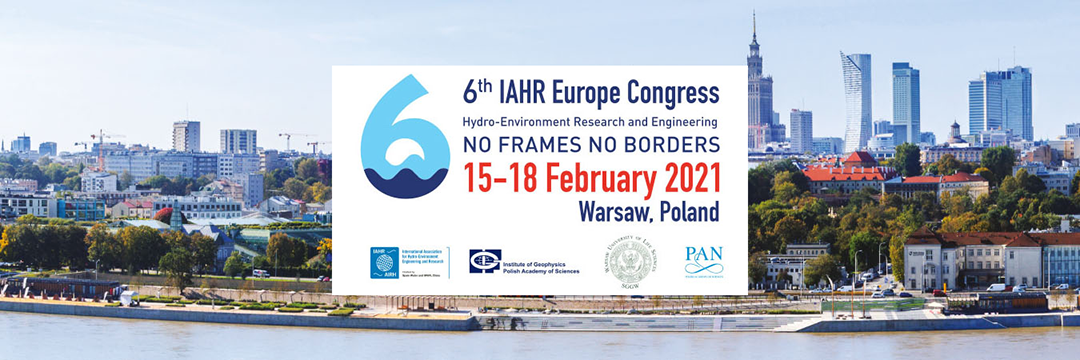
Access the Congress video collection
The 6th IAHR Europe Congress has just finished, and we can finally relax and breathe. Although it was a completely different event than we are accustomed to, the experiment was rather successful.
Needless to say that we had been preparing for the Congress for a very long time and originally it was planned to occur in the usual manner. Initially the 6th IAHR Europe Congress, titled “Hydro-environment Research and Engineering - No Frames, No Borders” was scheduled to take place from 29 June to 2 July, 2020. At first things looked very optimistic and more than 530 extended abstracts were accepted after thorough reviews (each abstract had two independent referees). The pandemic forced us to look for alternative solutions and the Congress was moved to February 2021. I had a chance to describe all the disruptions related to the organisation of the Congress in the August 2020 issue of NewsFlash Europe. When writing that text, I was hoping to be able to have at least a hybrid kind of Congress with a sufficient number of participants coming to Poland. Unfortunately, as far as the pandemic is concerned, a rather pessimistic scenario unfolded.
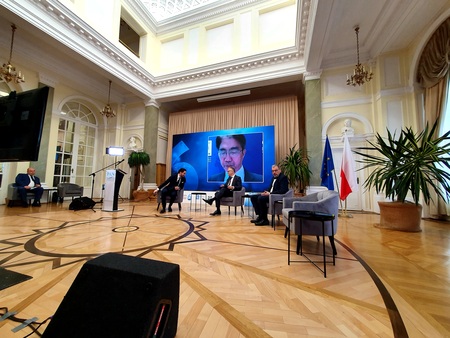 From other conferences we learned the lesson that attempts to replicate a real event on a 1-1 basis with a virtual one are doomed to failure and we decided to look for some innovative solutions.
From other conferences we learned the lesson that attempts to replicate a real event on a 1-1 basis with a virtual one are doomed to failure and we decided to look for some innovative solutions.
The Congress programme was organised into 3 paths: live sessions, oral sessions with pre-recorded talks, and poster sessions. Oral presentations and posters were divided into sessions according to the Congress themes and confirmed special sessions. This is to emphasize that special sessions were extremely popular and a great number were designed and convened from the bottom up by researchers from all over the world. That idea comes from the previous Congress in Trento and it turned out to be highly productive. 13 special session chairs decided to organise webinars allowing the discussion of all accepted presentations and posters and made sure to use time slots that did not overlap with the main live sessions. I need to strongly emphasize that the majority of the outputs of the congress are within the pre-recorded presentations and the advantage is that those presentations could be watched any time and will be available for congress participants for the next six months or so.
The Congress was designed in such a way that we had two major live sessions daily. We took advantage of the unique situation of the Polish Academy of Sciences having their Centers in major European cities. That allowed us to invite Congress keynote speakers to visit the centers in the countries where they reside so they could have live lectures with the full technical support offered by each center. At least it partially mimicked the situation of having our guests meeting in person.
Congress book of ABSTRACTS Special issue of ACADEMIA - The magazine of the Polish Academy of Sciences
Live sessions
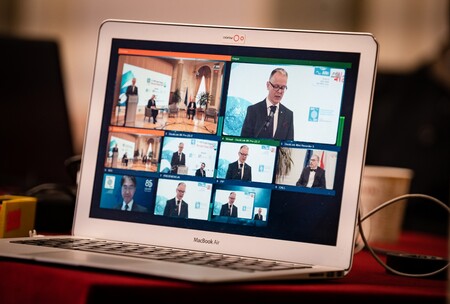 Let me just shortly describe each of the live sessions since they were decisive in creating an impression of the congress that the participants will likely have shared. Both opening and closing ceremonies were streamed free of charge so everybody could easily access them. Opening with the honorary participation of President Joseph Hun-wei Lee, Corrado Gisonni, IAHR Division Chair for Europe, Tom Soo, IAHR Executive Director, and also Abou Amani, the Director of the UNESCO-IHP Secretariat was a solemn ceremony. The heads of the three hosting institutions as well as the highly ranked representative of the Mayor of Capital City, Warsaw graced us with their presence as well. And the opening ceremony wrapped up with our first keynote lecture. Since originally there had been numerous plans for activities around the major Polish river, the Vistula, it was quite obvious that it should be the main subject of the lecture titled “Vistula River, an important watercourse not only in Poland” and was delivered by Artur Magnuszewski from the University of Warsaw. On a regional scale the Vistula River is a very important source of freshwater, sediments, and solutes to the Baltic Sea. Almost 50 per cent of river run-off to the Baltic Sea comes from 7 major rivers, with the Vistula coming in second position after the Neva River. It is noteworthy that in Poland the future of the Vistula is a subject of heated debate. In the plans of the AGN (European Agreement on Main Inland Waterways of International Importance) the Vistula plays an important role in the E40 and E70 waterways. This raises a question about the hydrological constraints for waterway class IV feasibility, conditions for sediment transport, and the ecological value of the middle reach of the river which has preserved its natural state to the present day.
Let me just shortly describe each of the live sessions since they were decisive in creating an impression of the congress that the participants will likely have shared. Both opening and closing ceremonies were streamed free of charge so everybody could easily access them. Opening with the honorary participation of President Joseph Hun-wei Lee, Corrado Gisonni, IAHR Division Chair for Europe, Tom Soo, IAHR Executive Director, and also Abou Amani, the Director of the UNESCO-IHP Secretariat was a solemn ceremony. The heads of the three hosting institutions as well as the highly ranked representative of the Mayor of Capital City, Warsaw graced us with their presence as well. And the opening ceremony wrapped up with our first keynote lecture. Since originally there had been numerous plans for activities around the major Polish river, the Vistula, it was quite obvious that it should be the main subject of the lecture titled “Vistula River, an important watercourse not only in Poland” and was delivered by Artur Magnuszewski from the University of Warsaw. On a regional scale the Vistula River is a very important source of freshwater, sediments, and solutes to the Baltic Sea. Almost 50 per cent of river run-off to the Baltic Sea comes from 7 major rivers, with the Vistula coming in second position after the Neva River. It is noteworthy that in Poland the future of the Vistula is a subject of heated debate. In the plans of the AGN (European Agreement on Main Inland Waterways of International Importance) the Vistula plays an important role in the E40 and E70 waterways. This raises a question about the hydrological constraints for waterway class IV feasibility, conditions for sediment transport, and the ecological value of the middle reach of the river which has preserved its natural state to the present day.
The real proceedings of the Congress started with a bang. The second live session was the UNESCO Special Session titled "Ecohydrology – translation of science into innovation and solutions". In accordance with the 8th phase of the UNESCO Intergovernmental Hydrological Programme (IHP-VIII), its leitmotif was Science and Global Water Security and the session was designed to show how integration of hydroengineering and the integrative science ecohydrology allows for development of innovative solutions towards solving global, regional, and local water problems. That session was chaired by Maciej Zalewski, the founding director of the European Regional Center for Ecohydrology of the Polish Academy of Science. It was a highly attended session since it was a combination of numerous short presentations and a debate in which Giuseppe Arduino, Chief of Ecohydrology, Water Quality and Water Education Section, Division of Water Sciences, Intergovernmental Hydrological Programme (IHP), UNESCO, Michał Kleiber, Head of The Polish Committee for UNESCO, Artur Magnuszewski, Artur Radecki-Pawlik, but also Giovanni Bidoglio, Delphis Levia and Jun Xia, among others took part.
The next session was hosted by the Polish Academy of Sciences Center for Historical Studies located in Berlin. A special bridge connection was established between the studio in Warsaw and in Berlin. The Berlin studio hosted Reinhard Hinkelmann, the Head of the Chair of Water Resources Management and Modeling of Hydrosystems at the Technische Universität Berlin (TUB) who agreed to chair the entire session and the two keynote speakers of the Congress. One was Jochen Aberle from the Technische Universität (TU) in Braunschweig and an active member of IAHR and the second one was the Vice-President of IAHR, Silke Wieprecht from the Institute for Modeling Hydraulic and Environmental Systems of the University of Stuttgart in Germany. The general scheme of the sessions was that keynote lectures were followed by a debate. During the Berlin debate panellists were focusing on the question “Can we find sustainable solutions for engineered water systems such as waterways and reservoirs?” and in the panel Kazimierz Banasik from the Warsaw University of Life Sciences and – as during each session - two Congress Chairmen played an active role. They were present in the Warsaw studio. Note that the number of panellists was limited by local pandemic rules in each of the hosting countries, therefore no other participants could be invited to the studios.
The first keynote lecture, titled “Methods to determine roughness and surface structures in alluvial streams and engineered waterways” touched upon the fundamental problems of hydraulic and environmental engineering, determining flow properties such as flow velocity distribution, mean velocities, flow rate, and turbulence characteristics. Prof. Aberle provided an overview of ongoing research studies with particular emphasis on his own rich research experience. The second keynote lecture, under an intriguing title “The 'Dirty Secrets' of Reservoirs", was devoted to the considerable negative impacts of multi-purpose reservoirs on the environment and local biodiversity, namely sediment deposition, cyanobacteria blooms, and greenhouse gas emissions.
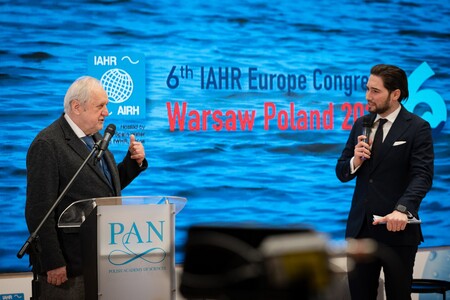 In the afternoon the stage in Warsaw belonged to young scientists and there was a live session titled “Water's next: Novel insights from young water scientists”. This session was led by our two colleagues - Michael Nones from the Institute of Geophysics, Polish Academy of Sciences and Mateusz Grygoruk from the Warsaw University of Life Sciences. The speakers were selected from among the awardees of the so-called PROM IGF grant and they presented cutting-edge findings developed by young researchers at the edge of hydrology and related engineering and environmental sciences. Note that originally those awards were to be the free tickets to the Congress.
In the afternoon the stage in Warsaw belonged to young scientists and there was a live session titled “Water's next: Novel insights from young water scientists”. This session was led by our two colleagues - Michael Nones from the Institute of Geophysics, Polish Academy of Sciences and Mateusz Grygoruk from the Warsaw University of Life Sciences. The speakers were selected from among the awardees of the so-called PROM IGF grant and they presented cutting-edge findings developed by young researchers at the edge of hydrology and related engineering and environmental sciences. Note that originally those awards were to be the free tickets to the Congress.
The next live session was related to the keynote lecture of Patrick Meire "Is ecosystem-based adaptation the answer to the challenges of climate change in estuarine and coastal systems?" Patrick Meire is full professor at the University of Antwerp and head of the ecosystem management research group. Prof. Meire raised the issue of an integrated ecosystem-based management of the Schelde estuary and extended this to a wider vision on managing coastal systems. He advocated for a more ecosystem-based approach using Nature-Based Solutions as a relevant approach. That session was hosted by the Polish Science Contact Agency (PolSCA) of the Polish Academy of Sciences in Brussels and again a kind of bridge between the studio in Warsaw and in Brussels was set up. The keynote lecture was followed by a debate on Nature-Based Solutions in coastal areas. The session was chaired from Warsaw by Jan Marcin Węsławski, the director of the Institute of Oceanology, the Polish Academy of Sciences and professor in marine ecology with the participation of the Congress chairs. In the Belgian studio the debate was enriched by the participation of Marc Huygens, Environmental Manager within the DEME (Dredging, Environmental, and Marine Engineering) Group, focusing on implementing environmental engineering solutions within DEME’s global international marine work. So in the debate we had both researchers representing academia as well as the industrial sector.
 The afternoon Wednesday live session was conducted in connection with the Polish Academy of Sciences Center in Vienna hosting Thomas Hein as the keynote speaker and two panellists - Elisabeth Bondar-Kunze, Senior Scientist at the Institute of Hydrobiology and Aquatic Ecosystem Management at the University of Natural Resources and Life Sciences and Robert Tögel, the head of Integrated River Engineering at Viadonau – Österreichische Wasserstraßen-GmbH. Dr Bondar-Kunze chaired the entire session. After the keynote lecture a discussion on the opportunities and challenges in the implementation of floodplain restoration in large rivers took place. The keynote lecture, titled “The potential of floodplain restoration to improve ecosystem functions and services at the river scale” concerned mostly the Danube River as a good example of the proposed solutions. It constitutes a highly complex socio-ecological system and a hotspot of biodiversity and ecosystem services, especially considering the floodplain systems, but it is also affected by multiple human activities like navigation, hydropower, urban development, or agriculture, making river-floodplain systems one of the most threatened ecosystems worldwide. An overview was given on the status of floodplains and their strategic importance at the whole river network scales, and examples were presented of how combined assessment approaches for biodiversity and ecosystem services could support restoration planning and the effect of implemented restoration measures on these floodplain properties.
The afternoon Wednesday live session was conducted in connection with the Polish Academy of Sciences Center in Vienna hosting Thomas Hein as the keynote speaker and two panellists - Elisabeth Bondar-Kunze, Senior Scientist at the Institute of Hydrobiology and Aquatic Ecosystem Management at the University of Natural Resources and Life Sciences and Robert Tögel, the head of Integrated River Engineering at Viadonau – Österreichische Wasserstraßen-GmbH. Dr Bondar-Kunze chaired the entire session. After the keynote lecture a discussion on the opportunities and challenges in the implementation of floodplain restoration in large rivers took place. The keynote lecture, titled “The potential of floodplain restoration to improve ecosystem functions and services at the river scale” concerned mostly the Danube River as a good example of the proposed solutions. It constitutes a highly complex socio-ecological system and a hotspot of biodiversity and ecosystem services, especially considering the floodplain systems, but it is also affected by multiple human activities like navigation, hydropower, urban development, or agriculture, making river-floodplain systems one of the most threatened ecosystems worldwide. An overview was given on the status of floodplains and their strategic importance at the whole river network scales, and examples were presented of how combined assessment approaches for biodiversity and ecosystem services could support restoration planning and the effect of implemented restoration measures on these floodplain properties.
The last keynote lecture was broadcasted from Sheffield from the home of our lecturer. Lockdown in the UK did not allow us to conduct the session in a studio at the University of Sheffield as we had originally planned. The technique we used, however, allowed us to have a live connection with the Warsaw studio and to have a relatively long question and answers session and rich discussions with the moderators, the Congress chairmen. The keynote speaker was Ian Guymer, Professor at the Department of Civil and Structural Engineering, at the University of Sheffield and the title of his lecture was “Longitudinal Dispersion – Exploring Limitations of Taylor”. This talk addressed some of the limitations related to aspects of mixing in urban drainage structures and pipes, focusing on modelling manhole mixing processes and unsteady flow effects in pipes.
It is worthy of note that after each keynote lecture all registered participants could ask questions that we then presented from the Warsaw studio. This way of interacting with keynote lecturers turned out to be highly successful and helped to maintain an interaction between the lecturer and the audience.
Closing ceremony
The last live session entirely from Warsaw was the closing and award ceremony with connections with Naples (Corrado Gisonni), Madrid (Tom Soo), and Athens (Anastasios Stamou) – the host of the next edition of the IAHR Europe Congress. A number of awards were announced during the ceremony, three of them being awards of the IAHR Europe Division.
Awards
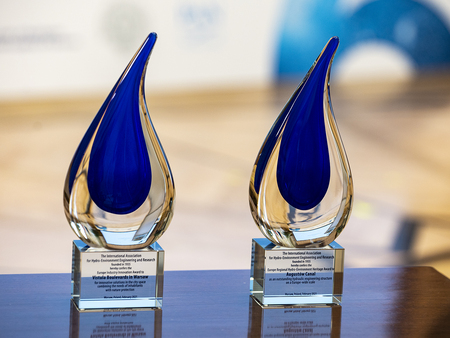 Industry Innovation Award
Industry Innovation Award
The first to mention is the Industry Innovation Award, conferred by IAHR during one or more of the IAHR Regional Congresses on a recent local innovation in design of lasting and international importance. It has the purpose of giving international professional recognition to the work of local hydro-environment engineers. This award was for the Vistula Boulevards in Warsaw, namely for the investment titled: Natura 2000 and Boulevards of the Vistula river in Warsaw – An Example of Compromises. On behalf of the Mayor of Warsaw this award was received by Justyna Glusman, Head Coordinator for Sustainable Development and Greenery of the Capital City of Warsaw. Revitalization of the Warsaw boulevards is an example of growing interest in bringing back the city to the river. The local authorities in Warsaw have become interested in improving the Vistula’s water quality and developing the trend of citizens spending their free time in the city. The creation of the “Vistula District” meets the expectations of the citizens and is an example of a modern design of a waterfront in combination with nature protection on the other side of the river. Applied principles of the design respect the fact that this is a high flood risk area. By adapting structures to flood conditions, the risk has been lowered to an acceptable level. On top of flood protection, designers of the Warsaw boulevard located on the left bank of the river had to take into account the process of river bottom erosion. Boulevards on the left bank have been rebuilt in two phases, with the first phase finished in 2015 and the second completed in 2017. The river with boulevards on one side and a natural forest on the other also offers different environments for people who wish to spend leisure time there.
IAHR Europe Regional Hydro-Environment Heritage Award
The second award was the IAHR Europe Regional Hydro-Environment Heritage Award and that prize was awarded to the Augustów Canal - a Unique Hydraulic Engineering Treasure. On behalf of the Marshall of Podlasie Voivodeship Artur Kosicki that award was received by Magdalena Sanczenko, Director of the Department of International Cooperation and Promotion. She was accompanied by the Mayor of the town of Augustów, Mirosław Karolczuk.
The Augustów Canal is a waterway crossing the main European watershed between the Vistula and Neman river basins. In the system of European inland waterways it connects the Vistula with the Neman, next to the Neman River with the Baltic ports in the Curonian Spit and with the Dnieper River basin through the Ogiński Canal, and the Dnieper through the Bierezinski Canal with the Daugava River. The construction of the Augustów Canal, designed by Ignacy Prądzyński, began in 1824 and was completed in 1838. At that time, it was the biggest project of the Kingdom of Poland and at the same time a pioneering water engineering project in Europe. The Augustów Canal is a cross-border technical monument located in north-eastern Poland and in north-western Belarus. It is a valuable historical monument, protected to preserve its historical, architectural, and technical heritage as well as the authenticity and integrity of the waterway. Today, almost 200 years after its construction, the Augustów Canal is still an exceptionally picturesque waterway enjoying great popularity among Polish and foreign tourists due to its meticulously preserved technical, architectural, cultural, and natural features.
It is noteworthy that both awards got substantial publicity in the Polish media and among the local authorities.
Gerhard Jirka Award
Another award of IAHR is the Gerhard Jirka Award introduced during the 5th IAHR Europe Congress in Trento in 2018 and created in memory of Prof. Gerhard Jirka to honour the best presentation given by a Young Professional during the biennial IAHR Europe Division Congress. It values the quality, originality, and relevance of the presentation. The first winner of the prize was Sebastian Schwindt, the 2nd winner was Melissa Latella, and the 3rd winner was Felix Beckers.
Awards by sponsors
A few sponsors offered additional awards, including Journal Water, MDPI, providing awards for the two best oral presentations and one poster presentation. Additionally, both the Polish Academy of Sciences and the Institute of Geophysics, PAS offered many scholarships as free tickets for the Congress.
Next IAHR Europe Congress
An important part of the closing ceremony was the presentation of the venue and plans for the next Congress which will take place in Athens. And we all hope it will be a real conference with the participation of a huge number of our colleagues from all over the world.
Final remarks and lessons learned
Coming to the substance of the matter, in recent years there has been serious widespread flooding within many of the countries represented by Congress participants. This has resulted in loss of life, risks to public health, damage to property and business, and damage to ecosystems, while at the same time we have also dealt with disastrous droughts. For example, we faced severe droughts in Poland. The significant economic and social implications of these droughts have led to growing concern and disquiet in many regions of the world because the frequency of those extreme events may increase as a direct consequence of global warming. We also note, and it was reflected in numerous presentations, that deterioration of water quality is not a new problem at all. Speeding up the development of water resources in various regions of the world and improvement of their environmental quality will result in the enhancement of people’s living standards as well as encourage the desire for peace. And under such circumstances we cannot forget about curiosity-driven basic research often bringing truly crucial transformations in our field of research. The motto of our Congress was “Hydro-environment Research and Engineering - No Frames, No Borders”. And I would like to place special emphasis on the main purpose of the congress which was to discuss ways not only to study but also to protect water resources, across and above the traditional borders between scientific disciplines. Issues related to hydrology and hydraulics straddle the fields of geophysics, physics, environmental research, civil and environmental engineering, as well as mathematics, chemistry, biology, and computer science. Other “borders”, as mentioned in the title of the congress include administrative borders, including between specific states. After all, nature does not recognize any such boundaries. Let me also stress that academia and science are in a prime position in gathering and sharing knowledge - and in this sense water is a theme having universal appeal.
There are numerous lessons that we have learned from the Congress. We definitely observe the interconnection of issues related to the motion of water with bio/eco components and therefore ecohydraulics or environmental hydrodynamics are appearing as emerging scientific disciplines. A lot of presentations touch upon various kinds of Nature-Based Solutions and, what was strongly echoed, such solutions must be sought for with the engagement of society and stakeholders.
Acknowledgements

The conference would not have been possible without the engagement of many people and institutions. In particular, I would like to mention Monika Kalinowska, co-chairing the Programme Committee and fostering the good spirit of the entire undertaking; Michael Nones, another co-chair of the Programme Committee taking on tasks not seen by everyone but necessary to run the Congress; Elżbieta Kujawska and her entire team, the heads and the teams at all the foreign centers of the Polish Academy of Sciences – in Vienna, Brussels, and Berlin and last but not least the company Nobell Congressing. I need to mention all session conveners and particularly those who designed and organised their own sessions, the reviewers of hundreds of abstracts, the committees evaluating the presentations and papers for numerous awards, and obviously the IAHR Europe Leadership Team for selecting Warsaw to organise the Congress as well as the IAHR Secretariat for their regular support. I need to acknowledge all those individuals who made efforts and preparations for the events that were later cancelled due to the pandemic– study trips, master classes, training courses. Thankfully two master classes still managed to take place.
The 6th IAHR Europe Congress in numbers
We consider the Congress a tremendous success despite the pandemic crisis all over the world and this success might be illustrated by the following numbers:
The Congress was organised by three institutions: the Polish Academy of Sciences, the Warsaw University of Life Sciences – SGGW and Institute of Geophysics, PAS.
Congress chairmen: Paweł Rowiński and Tomasz Okruszko.
500 participants with an average attendance at live sessions of 140-160 participants.
6 keynotes with a live stream from Warsaw.
56 sessions.
Special Session KS4: Towards sustainability in urban waters systems with the highest number of abstracts accepted (25).
13 live meetings for the special sessions.
425 papers accepted with 305 orals and 120 posters.
2 master classes.
52 countries with the largest number of participants from Poland (107) and then from Italy (57), the United Kingdom (30), and Spain (27).
For more info, visit the IAHR Europe Division
Subscribe to NewsFlash!